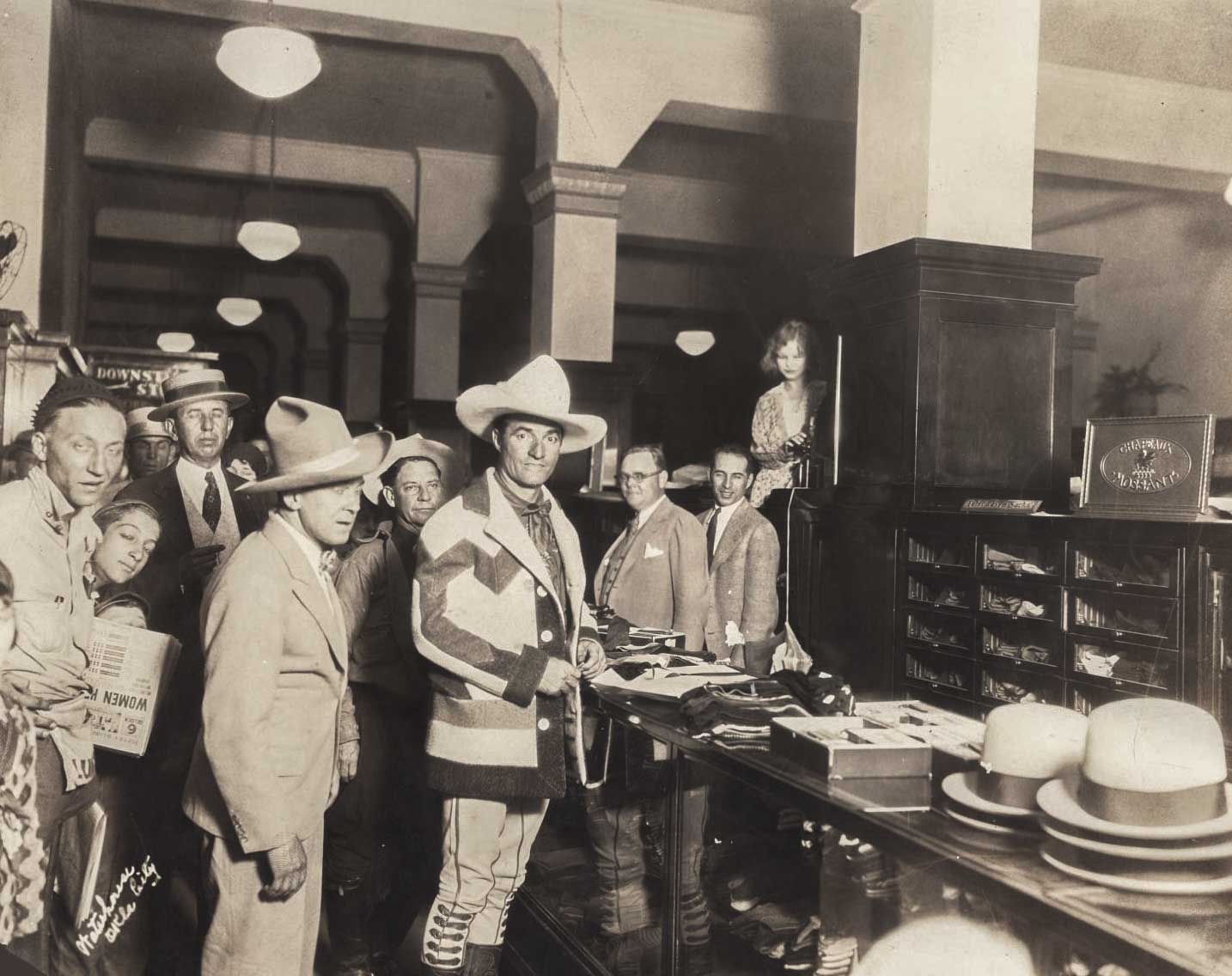
The Encyclopedia of Oklahoma History and Culture
COWBOY ACTORS AND SINGERS.
Oklahoma's role in the popularity of the "Western" movie is indisputable. Early in film history the Sooner State gained the title as capital of the "sagebrush sagas." While tens of thousands were participating in the land run that opened the Unassigned Lands of central Oklahoma to non-Indian settlement on April 22, 1889, another historical event on the East Coast was occurring. In Menlo Park, New Jersey, Thomas Alva Edison was demonstrating his latest invention, the Kinetoscope. Little could anyone have known that Edison's invention would team with some of the early settlers of Oklahoma, creating an art form that continues to fascinate viewers worldwide, the action-packed, death-defying "shoot-'em-up."
Before the Twin Territories were united into Oklahoma in 1907, before the Sooner State emerged as the center of the Western movie industry, it became the backdrop of one of the first "oaters," or "horse operas." In 1905 Pres. Theodore Roosevelt ventured to Oklahoma Territory on a hunting "safari." There the old Rough Rider witnessed a young Oklahoma cowboy, Jack Abernathy, do something extraordinary: Catch wolves with his bare hands. The president was so impressed by the dare-devilish feats of "Catch-'em-Alive-Jack" that he appointed Abernathy a deputy U.S. marshal. After Roosevelt returned to Washington, D.C., he was quick to recount his expedition, especially the exploits of the Oklahoma wolf hunter. Met by skepticism, the president had a crew film Abernathy in action. After completing The Wolf Hunt, the crew traveled to nearby Cache and produced The Bank Robbery, a recreation of an actual holdup there a couple of years earlier. Abernathy, U.S. Deputy Marshals Chris Madsen and Bill Tilghman, the notorious outlaw Al Jennings, and Comanche chief Quanah Parker were all part of the cast for the first shoot-'em-up filmed in Oklahoma.
From Art Acord to Tom Mix, from Jack Hoxie to the "original singing cowboy" Gene Autry, from Will Rogers to "Hopalong Cassidy" William Boyd, from Sunset Carson to Tim Holt, from Dale Robertson to Maverick (James Garner), Oklahoma's "sagebrush Galahads" have been featured on neon-lighted marquees nearly as long as pictures have been moving. Film makers gravitated to Oklahoma during the early 1900s, elevating the Sooner State to the position as capital of the "B" Westerns, produced on shoestring budgets but providing action-packed episodes of "they went that-a-ways." Hoxie and Acord were sitting high in the saddle by 1926. That February the popular Hoxie, born near Kingfisher only months after the land run, was featured in theaters across the nation. The billboard at the Wigwam Theater in Altus hailed the fearless cowboy as the "boys' favorite," and claimed the "saddle saga" was filled with "action, thrills, and stunts." A few months later Acord was promoted at the Palace Theater in nearby Blair. Acord, who was also born in Oklahoma Territory soon after the mad dash for land in 1889, was the star of Sky High Corral, described as a "real outdoor western" that offered "something for everybody, young and old." Acord's trusty mount, Black Jack, was also there to help his owner "rout the cattle rustlers" in the thrilling Blue Streak Western. In 1920 Oklahoma was also the scene of an all–American Indian motion picture, The Daughter of Dawn, filmed near Lawton in the Wichita Mountains Wildlife Refuge.
Hoxie, Acord, Mix, and others typified Oklahoma's "reel" cowboys during the silent era. They were tall, strong, and soft-spoken but fast riding, quick on the draw, and dynamite with their fists. Their horse operas were scripted by a standardized plot of good (white hats) versus evil (black hats), from dusty cow trails to cow towns, from twenty-four-hours-a-day saloons and gambling halls to the sheriff's office, from rendezvous to hideout, from bunkhouse to vine-covered cottage, with chase after chase filling the big screen. Oklahoma cowboy heroes such as Jimmy Wakely or Lon Chaney wore white ten-gallon hats, denim pants, high-heeled boots, neck scarves, and, of course, six-shooters low on their hips. They possessed a certain swagger that let everyone know they would rid the town of the ruthless desperadoes or die "with their boots on, tryin'."
With a stable of matinee idols, Oklahoma was a natural locale for the "B" Westerns. "Reel" cowboys easily took on the role of heroes. Many of them had been top rodeo performers who had exhibited their skills at the world-famous Miller Brothers 101 Ranch Wild West Show or Pawnee Bill's Traveling Wild West Show. The introduction of sound in the late 1920s changed the Western movie. While many of the matinee idols of the "silents" were talented on a horse and with the draw, they were tongue-tied by scripts. "Talkies" took over in the 1930s. No matter, the Western focus remained constant: Virtue overcomes vice.
Singing cowboys like Roy Rogers and Gene Autry, as smooth with the word as the draw, took over. Purely dramatic productions followed, continuing until the 1970s. Buck Jones, William "Hopalong Cassidy" Boyd, Sunset Carson, Dennis Weaver, Hoyt Axton, Brad Pitt, Will Sampson, Clu Gulager, Sheb Wooley, Chuck Norris, Wes Studi, Ben Johnson, and Van Heflin are among the hundreds who have graced the Silver Screen as "reel" Oklahoma cowboys.
See Also
COUNTRY MUSIC, FILM IMAGES OF OKLAHOMA, RECREATION AND ENTERTAINMENT, RODEO, WILD WEST SHOWS AND PERFORMERS






